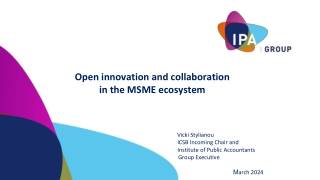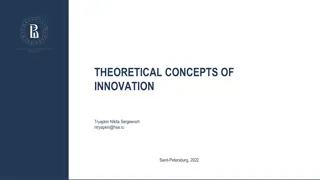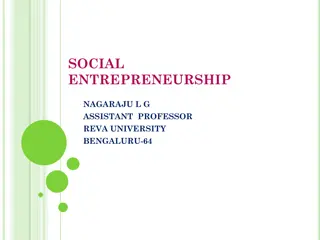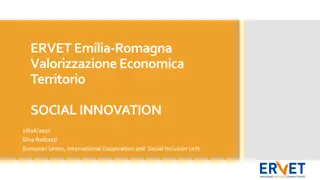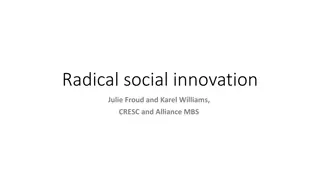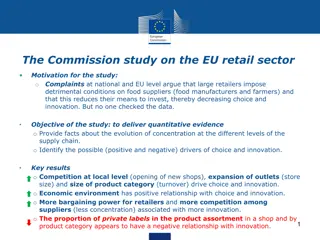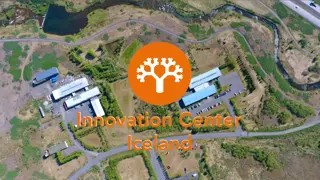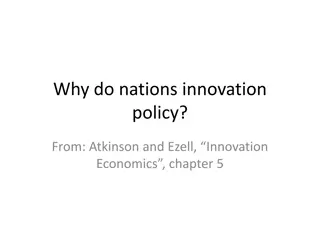Social Innovation and Social Change: Increasing Impact
Explore the concepts of social innovation and change in the context of societal and economic development. Delve into the key principles of social innovation, its impact on society, and the characteristics that define a practice as a social innovation. Understand the complexity of assessing and analyzing social impacts and the importance of societal dynamics in driving social innovations forward.
Download Presentation

Please find below an Image/Link to download the presentation.
The content on the website is provided AS IS for your information and personal use only. It may not be sold, licensed, or shared on other websites without obtaining consent from the author.If you encounter any issues during the download, it is possible that the publisher has removed the file from their server.
You are allowed to download the files provided on this website for personal or commercial use, subject to the condition that they are used lawfully. All files are the property of their respective owners.
The content on the website is provided AS IS for your information and personal use only. It may not be sold, licensed, or shared on other websites without obtaining consent from the author.
E N D
Presentation Transcript
SI-DRIVE Final Conference 2017 Social Innovation and Social Change How to increase the impact of social innovation Josef Hochgerner, Centre for Social Innovation (ZSI) and European School of Social Innovation (ESSI) 24thof October 2017, 3:30 p.m. The Royal Flemish Academy of Science and the Arts, Brussels This project has received funding from the European Union s Seventh Framework Programme for research, technological development and demonstration under grant agreement no 612870.
SI-DRIVE Final Conference 2017 SI-DRIVE Final Conference 2017 Innovation The key principle of understanding social innovation is contrary to many common prima vista assessments the notion of innovation, not doing something social in the sense of welfare, care or aid. According to the mainstream concept of innovation, an innovation is considered a product, process or service which proves superior to other (older or contemporaneous) products etc., and thus becomes successfully introduced in markets, to emphasize this a bit: in the market economy. Schumpeter in his very original publication of the Theory of economic development (1912) pointed out that business firms, an SME or multi-national corporation alike, are deemed to permantly develop new products and processes by recombination of the production factors (soil, labour, capital). Thus an economic enterprise actually must re- invent itself to avoid downturns of revenues and potential collapse. PAGE 2
SI-DRIVE Final Conference 2017 SI-DRIVE Final Conference 2017 Social innovation As economic development is in the core of innovation, so is societal development in the core of social innovation: An innovation is social to the extent that it varies social action, and is socially accepted and diffused in society (D 1.3, 58) The SI-DRIVE approach to social innovation looks out for new combinations of practices, i.e. new figurations of doing things, of modes and patterns of social action. They are prompted and adopted by actors (individuals, groupings or any type of organisation) in parts or rarely the whole of society. Regarding the commonly used but widely indeterminate term social change , social innovations may be drivers or transformers, as well as subject to change by social dynamics (more appropriate than social change ). Yet whatever term social change or social dynamics we use: Social innovation is part of it, and its impact depends on the socio- demographic properties, expectations, opinions and interests of those affected. Impact is the essential criterion to identify new practices as social innovation. However, the prefix social does not necessarily imply that impacts will be good or even better for all affected. Whether or not a social innovation proves better, as good as, or worse than previous and competing figurations of practices is a very special task in the processes of initiation, implementation and analyses of impact(s) born by social innovations. PAGE 3
SI-DRIVE Final Conference 2017 SI-DRIVE Final Conference 2017 What makes a figuration of new practices a social innovation ? Characteristic properties of the new practices in the course of SI development Novelty of the idea: Rarely in absolute terms, usually relatively better in respect of the location, time, social strata, or field of action concerned Social quality of the intervention: Involvement and active participation (involvement) of the beneficiaries and other stakeholders Sustainability of the implementation: The new practices are accepted, adopted and performed by the those concerned Notable impact: Effective practices become operational and replicated beyond the pioneering initiative (project); replicability and up- or outscaling instigate or modify social change Award criteria applied by SozialMarie , Austrian Prize for Social Innovation: www.sozialmarie.org PAGE 4
SI-DRIVE Final Conference 2017 SI-DRIVE Final Conference 2017 Social change To consider social dynamics avoids the potential trap of looking at social change as a sequence of seemingly stable states of societal development. (D 1.3, 6) This again depicts an analogy to Schumpeters basics of economic thinking, namely to consider economic development not as moves from one stable state to another one, but to see it as chains of unstable equilibria, not leaning towards a stable state, but innately to change. Social change is not simply the combined result of all social innovations. The key issue in understanding and analysing the relationship between social innovation and social change is to 1. identify and determine the characteristic features of ongoing social dynamics (change) in a society at a certain time and/or in a particular region on the one hand; and to 2. establish a typology of social innovations, based on what sort of impact they deliver, on the other hand. A third step of analysis would then allow to clarify the interplay, reciprocal effects and mutual reactions between specific social innovations and the broader waves of social change in a society under concrete historic and regional conditions. (cf. Slide # 7) PAGE 5
SI-DRIVE Final Conference 2017 SI-DRIVE Final Conference 2017 Characteristic features of social dynamics What is social change from a sociological point of view? Zapf (2003) denotes five dimensions or levels of social change: Socio-economic structures and social systems Institutions (social and adminstrative/organisational ones) Cultural patterns ( Frames of reference , what is normal ) Behaviour (individuals, groups, responses to norms, values) Consciousness (perceptions, acceptance, resistance, hopes/anxieties) This definition provides guidance into which domains we should look at when analysing impact of social innovation. However, it should not lead to the tempting conclusion, abstract indicators of structural, institutional or behavioural change would allow factual measurement of impact. Instead, if we want to single out impacts of social innovations, we need to stick to the concept of say mutations of processes in order to identify the endogen, relational and reflexive impact of social innovations in the complex and wide arena of social more general social dynamics. PAGE 6
SI-DRIVE Final Conference 2017 SI-DRIVE Final Conference 2017 The CULTURAL LEARNING CYCLE Behaviour, social action & potential change Opinions, attitudes Knowledge, awareness social innovations Roles New practices = Filtered Information Relations Norms Selective perceptions Values Established social and cultural patterns maintained by relatively stable frames of reference [facilitating easy comprehension of, and compliance with what is normal ] PAGE 7
SI-DRIVE Final Conference 2017 SI-DRIVE Final Conference 2017 The range of changes in social dynamics A first proposition to narrow down the vast and unclear, often even confusing multitude of activities termed social innovation in all sectors of the society, was laid out by BEPA (2010, 26f.): Three perspectives to analyse objectives and impact: o The social demand perspective, o The societal challenges perspective, and o The systemic change perspective Agn s Hubert et al. (BEPA Bureau of European Policy Advisors) 2010: Empowering people driving change. Social Innovation in the European Union. http://ec.europa.eu/bepa/pdf/publications_pdf/social_innovation.pdf Most social innovations address direct needs of certain groups of people, and usually they have limited potential to scale. However, social relevance must not be seen as a result of scaling; relevance stems from the urgency of needs and potential effects of unmet needs. When it comes to social innovations adressing (big) societal challenges, or even systemic change (transformative social change), it becomes more difficult to (a) find examples, and (b) to collate concrete effects (impact) of social innovations to such major and sometimes disruptive developments. - Last but not least: It makes a big difference, if a social innovation aims at changes on community- or on societal level! [cf. slide # 10] PAGE 8
SI-DRIVE Final Conference 2017 SI-DRIVE Final Conference 2017 Global challenges are rapidly changing living and working conditions at individual, groups, organisations , and societal levels Climate Change Conflicts National, religious, civil and international wars, flight and migration Environment Energy Poverty Income disparities, centre-periphery, exclusion, crime Mechanisation Industry 4.0, synthetic biology, nukes, ... Public finances Taxes, debts, social systems, health & care Labour Ways of working, working conditions, salaries, security, alienation PAGE 9
SI-DRIVE Final Conference 2017 The scope of social innovations: Society community Society Shaped on (historic, regional, economic) purposes states, nations, corporations Formally defined and documented membership, changeable (e.g. citzenship) Rules and regulations shall be in line with values, yet are dominant Rules are legitimate and binding beyond personal relations (e.g. in communities !) Functions in principle independently from individuals (depiction in an image: Society appears Domino-like ) Community Emerges and develops in organic (from blood to associations of likeminded) Emotional connexions, membership is (basicly) un-conditional and subjectiv after birth, initiation ritual adoption Examples: Family relatives, gang political groupings danger: People s community [ Volksgemeinschaft ] Common values dominate rules Existence and functioning depends on particular individuals (often charismatic leader/ F hrer ; depiction: Puzzle ) Bildergebnis f r domino Members: may vary, according to rules, official roles are widely independent from individual preferences. Bildergebnis f r puzzle Members: substitution rather difficult or even impossible, offices/duties/functions formed more by incumbents than rules. Society can expand (almost) unlimited, includes a lot of communities; and may in case of crisis dissolve into (conflicting) communities. Communities are limited in size/numbers, do neither necessarily create, nor necessarily strengthen a fundamental difference! Society. PAGE 10
SI-DRIVE Final Conference 2017 SI-DRIVE Final Conference 2017 Society generates innovations to expand ranges of action ... ... and reaches sometimes out to very spectacular achievements: The dominant innovation culture mainly drives changes in societal sediments by technology: (1) Technology made skin of society (2) The power structures in society (3) Modes of communication in society, between individuals, organisations, organisms and artifacts (4) Frames of reference, shaping manners, mores, myths & rites (5) Emotional balance in a society (security / insecurity, hope / fear, empathy / hatred ) Earth rise from moon orbit, December 24, 1968 A walk in the sunshine, July 21, 1969 Not one big innovation, nor a series of innovations only! result of a powerful socio-technical system, enabled by a particular innovation culture PAGE 11
SI-DRIVE Final Conference 2017 SI-DRIVE Final Conference 2017 All innovations are socially relevant, i.e. they impact all sediments yet: different degrees and pace, and by diverse methods Technology innovations affect Environ- ment The physical environment Power relations Power Over- laps Communication Communication Frames of reference Frames of reference Emotional balance Emotional balance Social innovations affect PAGE 12
SI-DRIVE Final Conference 2017 SI-DRIVE Final Conference 2017 A short outlook on future impact measurement Only if implemented and accepted by people and social entities concerned, new practices or varied forms of social action cross the threshold from an idea or invention to become an innovation, visible and determinable by its impact. Thus the implementation of new practices asserting impact on living and working conditions (ways of life), either of individuals, certain social groupings and organisations in parts or the whole of a society shall be considered social innovation and may alter or nudge social change in some way. SI-DRIVE was not intended to deliver a ready-made or even tested methodology to measure impact of social innovations. Nevertheless, a promising strategic perspective for future research might be developed along the following lines (keywords): Pull together statistical data available from around the world indicating degrees of human and social development in countries and world regions (UN: HDI, World Bank: World Development Indicators, Social Progress Index, World Wealth Report, and more). Analyse the strong and weak points in comparative studies to identify country-wise pressing issus on either scale (immediate social demand, societal challenges, systemic and transformative change). Then relate social innovations in the respective countries to the dominant issues to measure impact per country or region. PAGE 13
SI-DRIVE Final Conference 2017 SI-DRIVE Final Conference 2017 Impact characteristics of diverse types of social innovation From cases of social innovations in the SI-DRIVE database we learned that some form of co-creation is common to all social innovations At the same time, social innovations seem to provide at least some kind of empowerment at least one generic social impact. In addition, social innovations are embedded in a great variety of eco-systems, ranging from conducive to hostile socio-economic and cultural environments. When analysing such properties, objectives and processes of the cases six typical models of social innovations turn out to appear widely spread across the world regions surveyed: (1) Social innovation as new or improved service (2) The DIY (Do-it-yourself) model: Social innovation as self-help (3) Social innovation emerging from co-creation (4) Social innovation as a cooperative (5) Social innovation initiated to drive social change (6) Support measures improving the social innovation eco-system PAGE 14
SI-DRIVE Final Conference 2017 SI-DRIVE Final Conference 2017 Conclusion: Ways to increase impact (very pragmatic) (1) Still necessary: Improve the comprehension of what social innovation is and is not in the general public, scientific, political and practitioners communities. (2) Intensify learning from social innovation projects (successful ones as well as failed attempts), in particular concerning procedures leading to institutionalisation of SI. (3) Establish platforms and institutional collaboration among social innovation organisations of different kinds to better provide education, training, research and advisory services. (4) Develop stable social innovation eco-systems in cities, regions, countries and on European levels; this requires close collaboration with administrative bodies from local till European levels, yet also with actors and carriers of RTDI policies. (5) Quality, ambitious claims, competence and preparedness to take risks above quantity and social innovation labelling. PAGE 15
SI-DRIVE Final Conference 2017 SI-DRIVE Final Conference 2017 Thank you very much! www.si-drive.eu Prof. Dr. Josef Hochgerner, Zentrum f r Soziale Innovation, ZSI Centre for Social Innovation, Vienna. www.zsi.at, hochgerner@zsi.at PAGE 16



